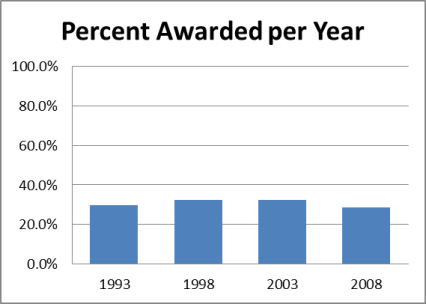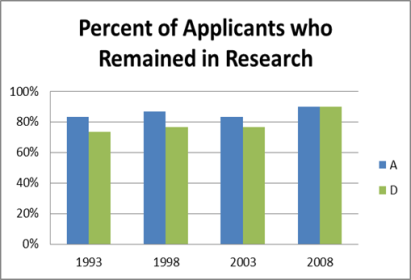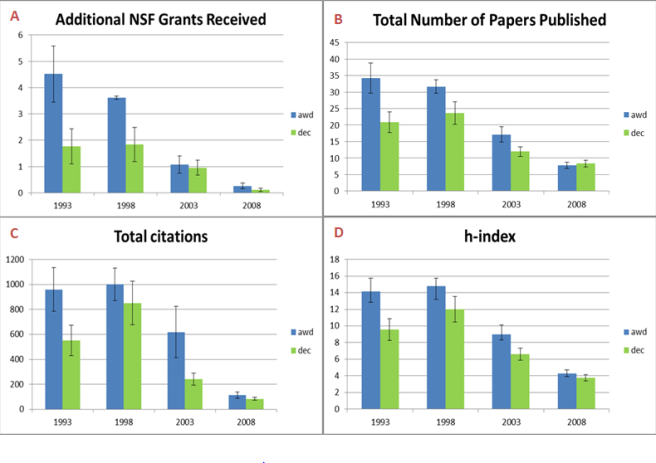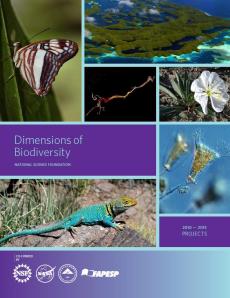Annual and final reports have changed quite a bit over the years. Twenty years ago annual reports and final reports were distinct requirements (see section 340) for which you printed out a form, filled it out and mailed it in. In the early 2000s reporting moved online to FastLane; this allowed a degree of integration with other electronic systems and also brought about the creation of a single template that applied to both annual and final reports. Some people took this to mean that the final report was just another annual report, and others started treating each annual report like a cumulative final report. However, since 1) most reports during the FastLane era were uploaded as unstructured PDF narratives they could be reviewed but weren’t useful for systematic analysis (data mining) and 2) both approaches provided the necessary record of activity, there was no pressure to enforce a standard either way on whether the content was annual or cumulative.
The most recent move, to Research.gov, came with a more structured web-form-based report template that enables further integration of reporting requirements into companion systems. The structured report data improves compatibility between grant data systems across agencies (e.g., NASA data in Research.gov search results) and adds records to a database of project results that can automatically compile the cumulative outcomes for any project without the PI having to regurgitate the same items over and over in an ever-expanding list. Once we get beyond the rough period of adjusting to the change, structured reporting of data can be easier to enter and provide greater value for analyses of all types, including those to make a case for future investments in research.
The purpose of this post is to help you shorten the learning curve of Research.gov reporting, answer some of the common questions we hear from you, and debunk the persistent myths and old habits that no longer fit with current practice.
- What does DEB do with project reports?
Reports are required because we need to maintain a record regarding how our investments in research are spent. We use them to make the case to various audiences that funds are being spent on good and important work. Your Program Officers (POs) are responsible for overseeing those funds and need to be able to document that they were used for the approved purposes in an appropriate fashion. Because failure to show that grant money was used productively makes it very difficult to justify sending you more money, POs review each report and will request additional information if critical aspects are weak or missing. Failure to report at all places a flag on your file for missing a requirement of your grant that will block further funding until it is cleared. In short, reports are a necessary component of financial stewardship.
With structured data available via the Research.gov reporting form, we are also gaining the ability to better quantify research outcomes and ask new questions about our portfolio, our decision-making, and the effects of different approaches to supporting science.
- What should I put in my project report, and how much of each thing?
This is a really common question and a big part of the change from FastLane reporting to Research.gov reporting. The old “upload a PDF” days imposed no limitation whatsoever on reporting and inconsistent requests for more or different information from POs in various programs encouraged a narrative-intensive “everything and the kitchen sink” approach to the report. This resulted in the expenditure of a lot of time and effort by PIs to compile and present all that information and by POs to wade through it to check if the critical pieces were all there.
Please take this to heart: The volume of report text is not an indicator of the quality of the work. A report is also not a journal article.
What we want is an efficient description of what happened/was accomplished during the reporting period. A lot of this comes down to discrete counts of the inputs, activities, and outputs of the project and providing enough detail about each that we could verify the count if needed. The Research.gov template seeks to encourage this by providing clear fields to generate list-style report items with consistent detail requirements.
There are some places with paragraph-sized text boxes for narrative explanations. Some are optional and some are required. Responses to any of them are most helpful when clear and direct. Research.gov imposes character-limits on text boxes where narratives are required/allowed by design.
- What are the most common problems that cause POs to return a report for revision?
- Failure to list participants and collaborators who are mentioned/described in narrative sections of the report text (See Questions 4, 5, and 6).
- Multiple typographical errors; apparent cut and paste errors (incomplete sentences or paragraphs).
- Listing items that fall outside of the reporting period.
- Who should I list in the Participants section? The other collaborators section?
Between the three “Participants/Organizations” sections, please list everyone who has been engaged in the project within the previous 12 months. This includes students, volunteers and those paid through other sources. As long as their activities were related to the objectives (Intellectual or Broader Impact) of your award, they “count”. A rule of thumb in deciding which section to report under is that individual “participants” carried out the work of the objectives, “organizational partners” directly enabled the work done by the participants, and “other collaborators or contacts” would include indirect supporters or beneficiaries of the work (e.g., schools at which your student conducted a demonstration). Please note that “other collaborators and contacts” are entered into a plain narrative text-box; it doesn’t include any specific structure or data requirements.
If participants worked less than a total of ~100 hours (2.5 weeks), enter “0” under Nearest Person Month Worked. (Yes, zeros count, too.) If they worked far less than 100 hours trust your own judgment about whether to list them as participants– i.e., whether you think their participation was meaningful, or might be better listed as an “other collaborator or contact”.
- I have multiple sources of funding and people in my lab often work on overlapping projects. In the Participants section, what should I enter for Funding Support?
If a participant was paid from a funding source other than your current NSF award, please list that source of support. Do not enter anything if the participant was paid solely from your current NSF award or if they were a volunteer.
- I have an RCN or workshop award (or any other type award that may involve dozens of participants). Do you really want them all listed as Participants?
Yes. The list of participants provides an increasingly valuable database that NSF can use to quantify the impact of its investments. A common alternative to listing participants individually in the Participants section has been to upload a pdf document under “Supporting Files”. Please keep in mind that NSF cannot search the data provided in those documents, except by opening them one-by-one, and they will generally be ignored in official analyses and comparisons. Hence we always prefer that Participants be entered one-by-one in the Participant section.
- I have a collaborative award. How should my reports differ from those of my collaborators?
Obviously, you and your collaborators will have at least some shared objectives and impacts; some overlap in reports is expected. Your report should focus on the components of the project and the personnel unique to your institution.
- Are Annual Reports cumulative? Is the Final Report cumulative?
No and no. Current NSF Policy and the Research.gov reporting system instruct PIs to report only on the previous year of work, including for the final report. Except for “Major Goals” and “Impacts”, there should be little or no overlap from one report to the next. The Final Report should be written as an Annual Report – there’s nothing special about it other than it being the last report on a given project.
You may have done it differently in the past or received outdated advice from a colleague because it was different in the past and old habits are tough to shake, but the rules were clarified and the system changed to enforce them when reporting was moved to Research.gov.
- What is the Project Outcomes Report?
The Project Outcomes Report is a third reporting requirement (in addition to annual and final reports) that is due at the same time as your final report. It is a counterpart to the “public abstract” of your award. The abstract was written at the start of the project and explained what you planned to do and why it was important. The Project Outcome Report summarizes the overall goal(s) and accomplishments of the project upon its completion. It is provided directly to the general public as a permanent record and justification for our investment of taxpayer dollars in your research. Please write it carefully, paying particular attention to the major accomplishments and general significance of your work; avoid jargon and grammatical errors. Do not cut-and-paste text from your Annual or Final Reports because you wrote them for a very different audience.
- What happens if I don’t submit my report?
You and any Co-PIs will not be allowed to receive any new funding (e.g., annual increments, supplements, or new grants) or process any other actions (e.g., no cost extensions, PI changes) until the report is submitted and approved. Your annual report is due starting 90 days before your award anniversary, your final report is due within 90 days after your award end date. After either of those 90 day windows, the report is considered “overdue” and the block is automatically put in place. Even if you aren’t overdue when you submit a report, waiting until late in the 90-day window risks delaying timely release of annual funds and possibly going overdue before we’ve had a chance to review, receive any needed corrections, and approve the report.
- I submitted my Annual Report, but there’s still a block in Fastlane preventing me from receiving new funds from NSF. Why?
It’s most likely that your report still needs to be approved by the managing Program Officer; new money cannot go out the door until reports have been submitted and approved. If your report has been languishing, it’s appropriate to ask the managing Program Officer to take a look at it. (Although we enjoy learning about your discoveries, annual reports can pile up when our priorities must be placed elsewhere.)
- Can I submit a proposal if I have an overdue report?
Yes. Be aware, however, that every time we attempt to access any of your proposals (submitted or already awarded), we’ll be redirected to a warning message on a separate screen that tells us we cannot approve any money for the proposal because of a missing or overdue report(s). We’re required to acknowledge this by clicking a “Continue” button before we’re allowed to see any of the proposal contents. The effect of those irksome messages on Program Officers is worth keeping in mind.
- If one of my collaborators has an overdue report on an award that I’m not associated with, what are the consequences for me?
If that collaborator is a PI/co-PI (i.e., listed on the cover page) of a proposal or award on which you are a PI/co-PI, you will be blocked from receiving any new funds from NSF or processing any other actions in relation to that shared proposal/award. Any proposal that shares a person on the cover page with the cover page of a proposal that has a missing or overdue report is subject to the block.
- Why am I being asked to submit my report in June or July when it’s not overdue until August or September (or later)?
Because we don’t want you to miss your annual funding increment. If you have received an award in the last quarter of our fiscal year (the fiscal year runs from October 1 to September 30, so July, August, or September) and are scheduled to receive that grant in annual increments then you have likely encountered this situation: a program officer calls you up and says “hey, can you get your report in this week” but when you look at research.gov it says it won’t be past due for a month (or two or three).
All annual reports are due 90 days before the anniversary of the award: this provides the time to review and process everything in order to get your annual increment released to you by the actual anniversary. Frequently, reports are submitted much closer to the anniversary or even late. This pushes the start of the approval process later and often pushes the release of money to after the anniversary. But, if that anniversary date is late in the fiscal year, any sort of delay — even within the allowed “reporting window” — can push back the processing time over the year-end deadline, at which point the money is no longer available to be released. That’s not a happy state of affairs for you or for us! So if your award was made and started on September 1, the report “due date” would be June 1 of the next year and your PO would probably be hounding you by July 1 to make sure you don’t lose your funding.
This is a little bit annoying, but generally makes sense when the project begins immediately upon receipt of the award. However, some awardees request a later “start date” for the project that is well after the actual award is made (someone receiving money in September might schedule a start date for December or January). At this point things get complicated. Following the September 1 award/January 1 start example: we need an approved report in order to release funds for the second year by the September anniversary of the award being made, otherwise we run out of time within the fiscal year to actually distribute the money. But, the reporting system is, for whatever reason, blind to this and tells you to file a report based on the “start date” so the very beginning of the “due” period is in October and after the point at which our ability to send you the money due upon receipt of that report has been canceled.
So, two lessons here: 1) don’t ask for a start date way after your award is available, especially if doing so crosses the Sept./Oct. dividing line, and 2) if your PO calls and asks you to submit a report RIGHT NOW, please do it; we’re trying to give you the money we promised and not doing it can really muck things up.
Additional Reporting Resources
More detailed answers to many of these questions and accompanying screen shots from Research.gov are available in a pdf guide available here (click to follow, but caveat emptor: there appear to have been some additional updates since the file was posted).
If you’re really into this, a long list of guides, tutorials, templates, and demonstrations related to Project Reports is available here .








 This
This